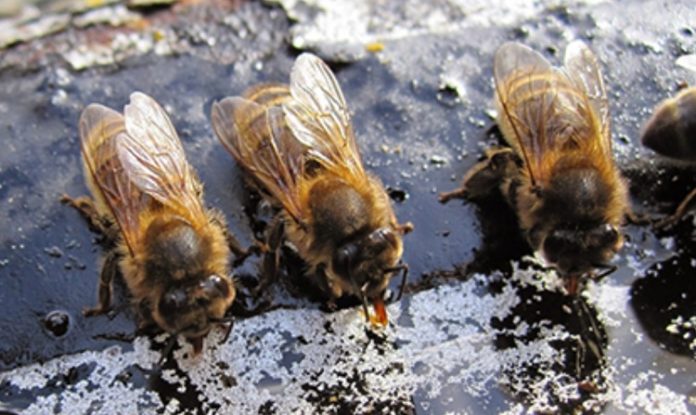
The Dallas County Environmental Health Department is participating in a statewide study to test well water for neonicotinoid insecticides, which are believed to be highly toxic to bees and linked to the rapid decline in bee populations.
All Dallas County residents interested in helping with the study by having their well water tested for free should call 515-993-3750. Volunteers will also receive information about their wells’ overall water quality and whether the wells are providing good, clean water to families.
“We did a fall project,” said Ted Trewin, director of the Dallas County Environmental Health Department. “In our area we didn’t find any neonicotinoids in the fall, but we’re going to do it here this spring to see if it really affects the ground water and is tracable with all the planting that’s commencing now.”
Trewin said the testing for neonicotinoids “is piggybacking off the grant-to-counties program,” which already tests private wells for a spectrum of contaminants, including levels of total coliform bacteria, e.coli, nitrate, nitrite and arsenic. Test can also be requested for other contaminants, such as fluoride, radium, lead, gasoline, plastics, adhesives, dry-cleaning fluids, refrigerants, paints and solvents and animal waste like manure, carcasses and compost.
A test developed in 2014 by the State Hygienic Laboratory at the University of Iowa can detect very low levels of the neonicotinoid insecticides that have been linked to the decline in bee populations. From July 2014 to July 2015, the number of samples received for this test increased by 63 percent.
Studies by researchers at the Harvard School of Public Health and other institutions have shown that these insecticides — used to treat corn and soybeans in Iowa and elsewhere — could play a role in colony collapse disorder, which has decimated honey bee colonies over the past decade.
“The amount of insecticide on one corn seed is enough to kill an entire colony,” said John Vargo, environmental lab scientist at the State Hygienic Laboratory. He said other factors, such as parasitic mites, also are thought to play a role in colony collapse disorder.
“Acute toxicity for most of these neonicotinoid insecticides by oral ingestion is estimated to be about 3-5 nanograms,” Vargo said. “The effects of long-term exposure to less than lethal concentrations of the pesticides is not known. The amount that we can detect in the test would be considered a concentration lower than a lethal amount.”
Seven neonicotinoid insecticides are included in the test: acetamiprid, clothianidin, dinotefuran, imidacloprid, sulfoxaflor, thiacloprid and thiomethoxam. All of these chemicals can be detected, quantified and reported at concentrations as low as 0.020 micrograms per liter, Vargo said.
Besides providing honey, bees do much of the work in pollinating a wide variety of crops, with pollinators responsible for every third bite of food we eat.
Vargo said the lab first began testing for neonicotinoids at the request of the Iowa Department of Natural Resources (DNR). The testing procedures use high performance liquid chromatography with tandem quadrupole mass spectrometric detection (LCMSMS), he said.
The tests were developed at the State Hygienic Laboratory in Iowa City.
The rapid and sensitive test can detect neonicotinoid insecticides at very low levels in surface, drinking and ground water, Vargo said. The lab initially tested surface water for the Iowa DNR in areas where water had pooled in farm fields after rain, and these samples showed positive detection of select neonicotinoids, he said.
“This technique is highly specific to the chemicals being tested,” Vargo said. The lab has since tested other samples for the DNR as well as a few additional requests.
Vargo said the testing procedure, which can cost $300 to $400, involves injecting water samples into the instrument, which are then analyzed.
Neonicotinoid insecticides are commonly used in seed treatments to protect the seed as it germinates and begins to grow. The amount of neonicotinoid insecticides applied to seeds range from a rate of 0.25-1.25 milligrams of active ingredient per seed.
The U.S. Environmental Protection Agency (EPA) estimates that nearly 35 percent of soybean seeds and more than 95 percent of corn seeds have been treated with one or more neonicotinoid insecticides, with imidacloprid, thiomethoxam and clothianidin being used most frequently.
Neonicotinoid insecticides also may be applied to the foliage of infested plants.
The insecticides are highly soluble in water and somewhat persistent in the environment, Vargo said, making it likely that the chemicals will be transported to groundwater or surface water through rain or irrigation.
He said bees may encounter neonicotinoids from dust containing the pesticides at the time of seed planting, from pesticide leaching from treated seeds in water and from spray drift from foliar applications to plants.
The EPA does not require public water supplies to be tested for neonicotinoid insecticides as part of the Safe Drinking Water Act, but Vargo said the tests can be useful for beekeepers, environmental groups and farmers who rely on bees to pollinate their crops.
Limited data is available on the impact of neonicotinoid insecticides via puddled water on pollinators, but a Canadian study showed that honey bees and native pollinators face an unprecedented cumulative exposure to the insecticides from combined residues in pollen, nectar and water.
Representatives of the Iowa DNR said the results of the farm field study are in the review process and awaiting publication.
















